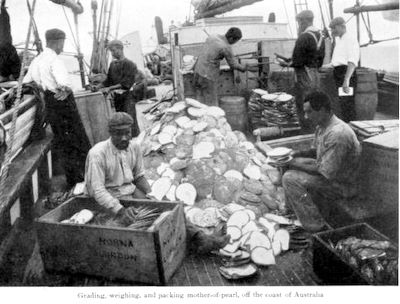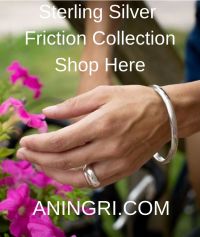|
Pearl Oyster Species in AustraliaThere are three main original pearl oyster species in Australia. At one time they were so plentiful....you could easily pick them up at low tide.  Packing Mother of Pearl in Australia I love Australia. I discovered "my sport" there....boogie boarding! What fun, to ride the waves back into shore while holding safely onto a boogie board. It's especially fun when you roll back in on the waves to cheers and thumbs-up from a group of Japanese tourists, cameras in hand. I've never received any cheers for my volleyball skills, that's for sure! This information about pearl oyster species in Australia is from the Kunz and Stevenson book about pearls, printed in 1908. Keep that fact in mind, while reading, that the information is a century old, when pearls were natural and not commonly cultured. There are three pearl oysters species in Australian waters. The largest species, Margaritifera maxima, which is by far the most important and widely distributed, occurs to a greater or less extent throughout the whole of this region. This yields the standard mother-of-pearl of commerce. Although the pearls which it yields are among the largest and finest in the world, this mollusk is sought more particularly for the shell, the value of which from season to season averages three or four times as much as that of the pearls. Ordinarily this shell is uniformly white over the entire inner surface, and is commonly known locally as "silver lip"; but some "golden-edged" shell occurs on the muddy grounds in narrow passages between the islands on the northwest coast. While this pearl oyster species in Australia is gregarious, it is not located in densely covered beds, but is scattered in patches over the reefs. Some of these are miles in length and contain scored of tons, but usually they are very much smaller. The oysters occur principally on rocky bottom, and also on clay and sand when well covered with seaweeds, but are rarely found on muddy ground. They are most numerous in the channels where the current is strong. The small oysters are generally loosely attached by the byssus to rock, gravel or other shells; while the mature ones lie loosely on the bottom or slightly turned in the sand. The second pearl oyster species in Australia, Margaritifera margaritifera, is smaller, rarely exceeding eight inches in diameter and a weight of two pounds. The distinguishing characteristic is the black edge bordering the inner surface of the shell, whence it acquired the local designation "black lip." This variety is not rare in Queensland, and in Western Australia its range extends as far as Champion Bay in Lt. 29°S. However, the catch is small compared with that of the Margaritifera maxima, amounting to only 2-3% in Queensland. In 1905, the export of "silver lip" and "golden-edged" from Thursday Island was 527 tons, and of "black lip" only 11 tons; in 1904, these figures were 778 and 7 respectively. In Western Australia the percentage of yield is much larger than this. The third pearl oyster species in Australia, Magaritifera carcharium, is confined almost entirely to the limits of Sharks Bay, on the extreme western coast of Australia. At maturity it is the smallest of the three, averaging three or four inches in diameter, and about equals in size the Lingah pearl-oyster of the Persian Gulf. The percentage of pearls therefrom is relatively greater than from the larger variety; but, owing to its small size and lack of thickness, the shell is of little commercial value. The value of the output in recent years has approximated £2,000-£3,000, which is very much less than formerly, the value of the shell having greatly decreased since the introduction of the Mississippi shell in button manufacture.
|











